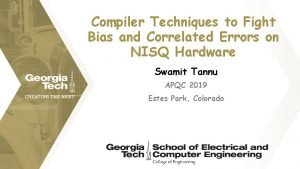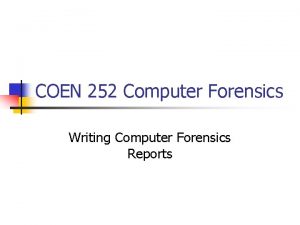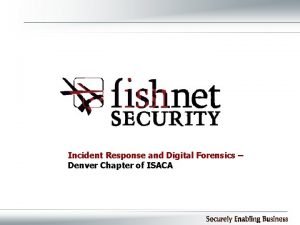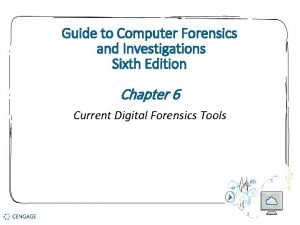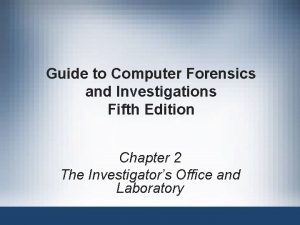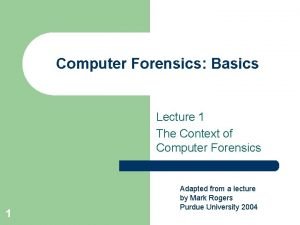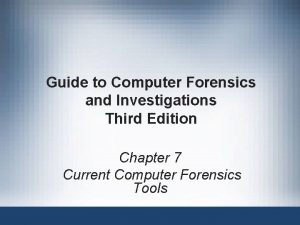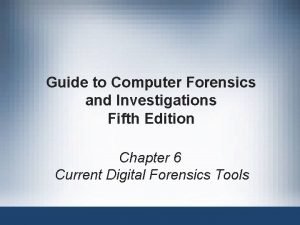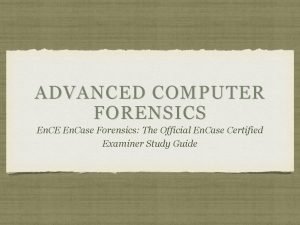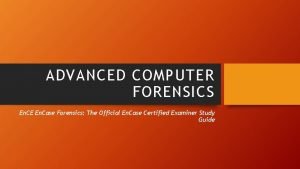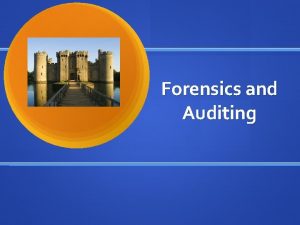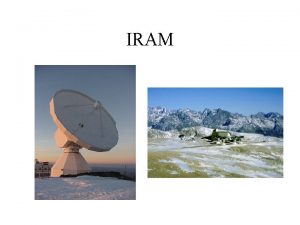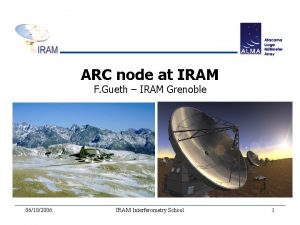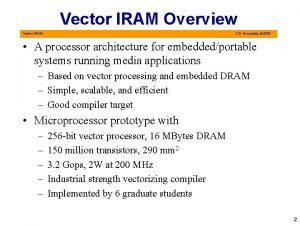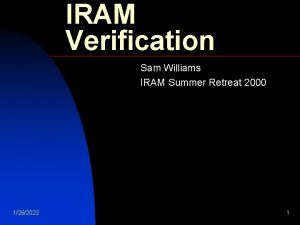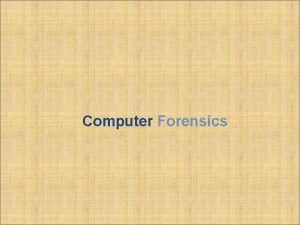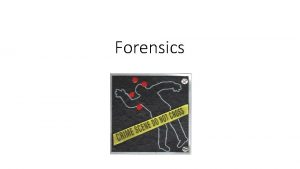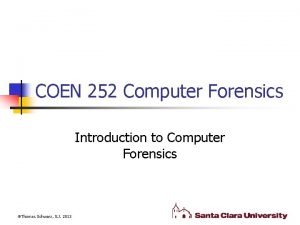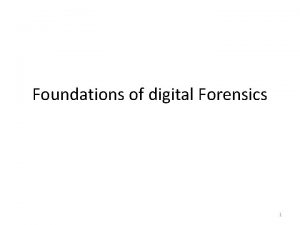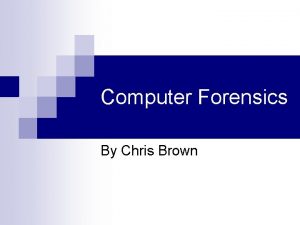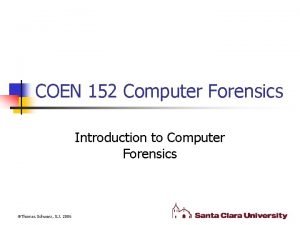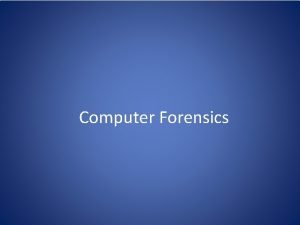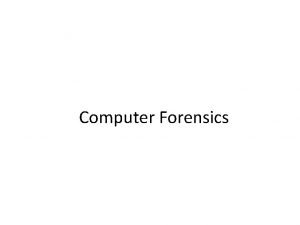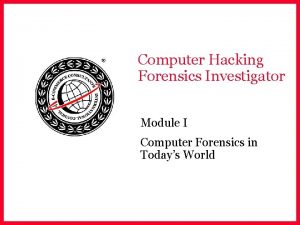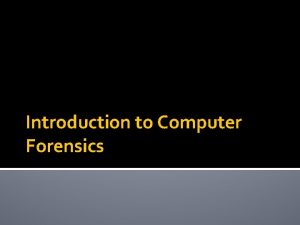Computer Forensics Iram Qureshi Prajakta Lokhande Topics to



















- Slides: 19

Computer Forensics Iram Qureshi , Prajakta Lokhande

Topics to be covered § Definition § Why Computer Forensics? § Who uses Computer Forensics? § Computer forensic requirements § Steps of Computer Forensics § Handling Evidence § Handling Information § Anti-Forensics § Methods of hiding Information/data § Methods of detecting information/data

Definition Computer forensics is defined as the discipline that combines elements of law and computer science to collect and analyze data from computer systems, networks, wireless communications, and storage devices in a way that is admissible as evidence in a court of law.

Why Computer Forensics? Reasons to employ techniques of computer forensics: Ø To analyze computer systems in legal cases. Ø To recover data in event of hardware or software failure. Ø To analyze a computer system after a break-in. Ø To gather evidence against an employee that an organization wishes to terminate. Ø To gain information about how computer systems work.

Who Uses Computer Forensics? • Criminal Prosecutors Rely on evidence obtained from a computer to prosecute suspects and use as evidence • Civil Litigations Personal and business data discovered on a computer can be used in fraud, divorce, harassment, or discrimination cases • Insurance Companies Evidence discovered on computer can be used to mollify costs (fraud, worker’s compensation, arson, etc) • Private Corporations Obtained evidence from employee computers can be used as evidence in harassment, fraud, and embezzlement cases

Who Uses Computer Forensics? (cont) • Law Enforcement Officials Rely on computer forensics to backup search warrants and postseizure handling • Individual/Private Citizens Obtain the services of professional computer forensic specialists to support claims of harassment, abuse, or wrongful termination from employment

Computer Forensic Requirements • Hardware – Familiarity with all internal and external devices/components of a computer – Thorough understanding of hard drives and settings – Understanding motherboards and the various chipsets used – Power connections – Memory

Computer Forensic Requirements • Software – Familiarity with most popular software packages such as Office • Forensic Tools – Familiarity with computer forensic techniques and the software packages that could be used (cont)

Steps Of Computer Forensics is a four step process. Acquisition • Physically or remotely obtaining possession of the computer, all network mappings from the system, and external physical storage devices Identification • This step involves identifying what data could be recovered and electronically retrieving it by running various Computer Forensic tools and software suites Evaluation • Evaluating the information/data recovered to determine if and how it could be used again the suspect for employment termination or prosecution in court

Steps Of Computer Forensics (cont) Presentation • This step involves the presentation of evidence discovered in a manner which is understood by lawyers, non-technically staff/management, and suitable as evidence as determined by United States and internal laws

Handling Evidence • Admissibility of Evidence – Legal rules which determine whether potential evidence can be considered by a court – Must be obtained in a manner which ensures the authenticity and validity and that no tampering had taken place • No possible evidence is damaged, destroyed, or otherwise compromised by the procedures used to search the computer • Preventing viruses from being introduced to a computer during the analysis process • Extracted / relevant evidence is properly handled and protected from later mechanical or electromagnetic damage

Handling Information and data being sought after and collected in the investigation must be properly handled. • Volatile Information – Network Information • Communication between system and the network – Active Processes • Programs and daemons currently active on the system – Logged-on Users • Users/employees currently using system – Open Files • Libraries in use; hidden files; Trojans (rootkit) loaded in system

Handling Information (cont) • Non-Volatile Information – This includes information, configuration settings, system files and registry settings that are available after reboot – Accessed through drive mappings from system – This information should investigated and reviewed from a backup copy

Anti- Forensics • Software that limits and/or corrupts evidence that could be collected by an investigator • Performs data hiding and distortion • Exploits limitations of known and used forensic tools • Works both on Windows and LINUX based systems • In place prior to or post system acquisition

Methods Of Hiding Data hiding is the process of making data difficult to find while also keeping it accessible for future use. Encryption • Encryption programs allow the user to create virtual encrypted disks which can only be opened with a designated key. • File level encryption Steganography Technique where information or files are hidden within another file in an attempt to hide data by leaving it in plain sight

Methods of hiding data (cont. . ) • Watermarking: Hiding data within data – Information can be hidden in almost any file format. – File formats with more room for compression are best • Image files (JPEG, GIF) • Sound files (MP 3, WAV) • Video files (MPG, AVI) – The hidden information may be encrypted, but not necessarily – Numerous software applications will do this for you: Many are freely available online

Methods Of Detecting/Recovering Data (cont) – Software analysis • Even small amounts of processing can filter out echoes and shadow noise within an audio file to search for hidden information • If the original media file is available, hash values can easily detect modifications

Methods Of Detecting/Recovering Data (cont) – Disk analysis utilities can search the hard drive for hidden tracks/sectors/data – RAM slack – Firewall/Routing filters can be applied to search for hidden or invalid data in IP datagram headers

THE END
 Weerstand
Weerstand Dr riaz qureshi
Dr riaz qureshi Samina qureshi md
Samina qureshi md Dr riaz qureshi
Dr riaz qureshi Moin qureshi gatech
Moin qureshi gatech Dr riaz qureshi
Dr riaz qureshi Xenial age range
Xenial age range Computer forensics report template
Computer forensics report template Guide to computer forensics and investigations
Guide to computer forensics and investigations Computer forensics denver
Computer forensics denver Building a forensic workstation
Building a forensic workstation Forensics
Forensics Objectives of computer forensics
Objectives of computer forensics Introduction to computer forensics
Introduction to computer forensics Computer forensics tool testing
Computer forensics tool testing Tasks performed by computer forensics tools
Tasks performed by computer forensics tools Tasks performed by computer forensics tools
Tasks performed by computer forensics tools Dr qaira anum
Dr qaira anum Advanced computer forensics
Advanced computer forensics Fastbloc se
Fastbloc se




